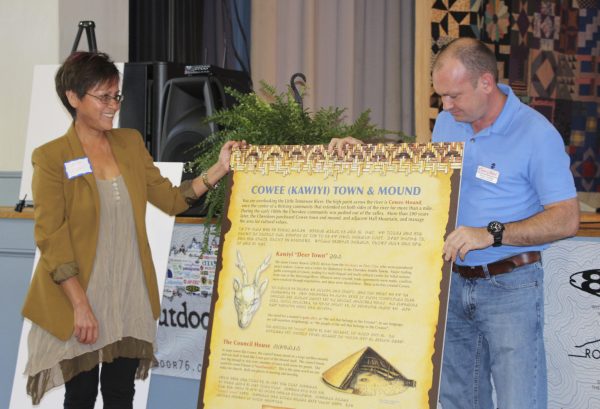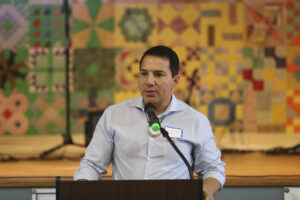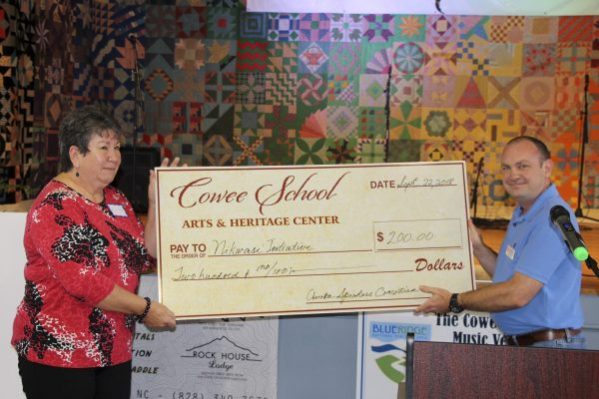
Stacy Guffey, Cowee School Art & Heritage Center director, unveil information panels that will be part of a new set of cultural kiosks at Cowee Mound during an event at Cowee School on the morning of Saturday, Sept. 21. (SCOTT MCKIE B.P./One Feather photos)
By SCOTT MCKIE B.P.
ONE FEATHER STAFF
COWEE – Panels featuring Cherokee history of the Cowee Mound and area were unveiled during a ceremony near the site on the morning of Saturday, Sept. 22. Part of the Cherokee Cultural Corridor, the unveiling and cultural kiosks were the result of a partnership between the Nikwasi Initiative, the Mainspring Conservation Trust, the Eastern Band of Cherokee Indians and entities such as the Cherokee Preservation Foundation, and the Cowee School Arts & Heritage Center – groups that came together collectively as Mountain Partners.
“It truly is a great day today,” said Principal Chief Richard G. Sneed. “We have had so many great partners in this project – folks with vision for the project of a Cultural Corridor. For thousands of years, prior to European contact, our ancestors dwelled here, and they had a rich culture, a vibrant culture with a complex religious and spiritual system, complex political systems, and complex economic and trade systems.”

HISTORY: Principal Chief Richard G. Sneed spoke during Saturday’s event and commented, “ The Cultural Corridor will ensure that our story, our rich, vibrant history, will be told not from the perspective of a conquered people but from the perspective of a strong, resilient, and proud people.”
Chief Sneed spoke to the importance of the cultural kiosks. “For hundreds of years, our story has been told by the conquerors. It has been said it is the conquerors who write history, and for probably the last 150 years or so, we, as a Tribe, have fought very diligently to tell our story in an appropriate manner.”
He spoke about the history of self-governance among all tribes including the Eastern Band of Cherokee Indians. “We have now come back to a time of full self-governance that continues to grow year over year over year as we exercise sovereignty as a nation within a nation. The Cultural Corridor will ensure that our story, our rich, vibrant history, will be told not from the perspective of a conquered people but from the perspective of a strong, resilient, and proud people.”
Town of Franklin Mayor Bob Scott related, “Today, I feel, begins a new era in preserving our magnificent Native American history with this Cultural Corridor. For generations to come, people will come, learn, and enjoy what we have here as far as our history is concerned. The Town of Franklin appreciates being a part of this effort and the program here today.”
He added, “We, the town, are proud that the Nikwasi Mound, the site of one of the Cherokee Nation’s most important settlements is one of Franklin’s most important sites. On behalf of the town, I wish you the best in this endeavor. This will be an important asset for many generations to come.”
Juanita Wilson, an EBCI tribal member and part of the Nikwasi Initiative, said, ““For me, this is an historic day. This is very important, and I don’t think all of the people in our communities understand how important this is. Our ancestors are smiling down on us today.”
She thanked the many partners who came together on the program and especially the Cherokee Speakers Consortium members who did the Cherokee language translations on the information panels for the kiosks. “These people who have come together are amazing. I am honored to have worked with them.”
EBCI Secretary of Agriculture Joey Owle commented, “We wouldn’t be where we are at in our history if it weren’t for our partners, and I want to say it has been a tremendous honor to work with the folks at Mainspring Conservation Trust, Tom, Maggie, everybody that has attended our Mountain Partners meetings and to just feel how important this effort is to preserve our history. It also includes the folks at the Town of Franklin and Macon County. It’s part of your history too.”

DONATION: Stacy Guffey (right), Cowee School Art & Heritage Center director, presents a $200 check to Mary Brown, a member of the Cherokee Speakers Consortium. The check was a donation to the Nikwasi Initiative in honor of the Consortium. A second check for $200 was also presented in honor of Chief Sneed.
During Saturday’s event, Stacy Guffey, Cowee School Arts & Heritage Center director, presented two checks for $200 each to the Nikwasi Initiative for use on the project. The first check was in honor of Chief Sneed, and the second check was in honor of the Cherokee Speakers Consortium.
“This should be a place for the Cherokee to tell their story,” said Guffey. “That’s the mission of the Corridor.”
TJ Holland, EBCI Cultural Resources supervisor, spoke of the effort to develop the actual information panels for the kiosks. “A lot of Cherokee history and stories is told in a nonlinear fashion so dates and things are not as important as they would be on a timeline. We talked about the idea that within these signs there would be a gift – there would be a story about what this really means. Linear history tells us the who’s, the what’s, and the where’s. But, these stories tell us why. And, so these stories will be told from a Cherokee perspective.”
Mary Brown, an EBCI tribal elder from the Snowbird Community and a first language Cherokee speaker, worked on the translations found in the kiosks. Speaking in the Cherokee language and then translating it into English, she noted, “Cowee was once the center of the thriving Cherokee community that extended on both sides of the river for more than a mile…the name Cowee derives from ani kawiyi which is the deer clan which people considered peacemakers.”
Brown said translations are always complicated due to dialect variations. “My dialect slightly varies from the speakers that I work with on the Qualla Boundary and also the speakers that I work with in Oklahoma. Nevertheless, we still understand each other…translation is a lengthy process. We try to honor each other…”
The next steps in the process will be putting in similar kiosks at the Nikwasi Mound in downtown Franklin.



